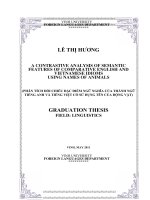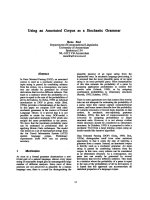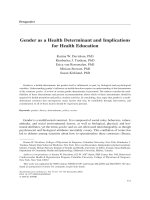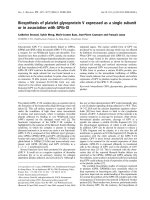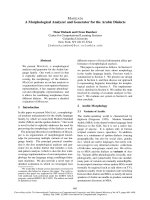STUDY OF USING [BMIM][PF6] IONIC LIQUID AS A GREEN SOLVENT AND CATALYST FOR THE SCHIFF BASE SYNTHESIS
Bạn đang xem bản rút gọn của tài liệu. Xem và tải ngay bản đầy đủ của tài liệu tại đây (663.54 KB, 9 trang )
<span class='text_page_counter'>(1)</span><div class='page_container' data-page=1>
<i>Tạp chí Khoa học cơng nghệ và Thực phẩm 13 (1) (2017) 39-47 </i>
<b>STUDY OF USING [BMIM][PF</b>
<b>6</b><b>] </b>
<b>IONIC LIQUID AS A GREEN SOLVENT AND CATALYST </b>
<b>FOR THE SCHIFF BASE SYNTHESIS </b>
<b>Nguyen Thi Hong Anh</b>
<b>1,*</b><b>, Nguyen Xuan Thao</b>
<b>2</b><b>, Phan Thanh Son Nam</b>
<b>2</b><i>1</i>
<i>Ho Chi Minh City University of Food Industry </i>
<i>2</i>
<i>Ho Chi Minh City University of Technology </i>
<i>*Email: </i>
Received: 29 June 2017; Accepted for publication: 28 November 2017
<b>ABSTRACT </b>
The [BMIM][PF6] ionic liquid that derived from dialkylimidazolium cations was
synthesized using MW-assisted method under solvent-free condition. The synthesis of
para-anisidineacetylacetone was then conducted in [BMIM][PF6] ionic liquid as solvent with good
conversion after 6 hours under ambient condition without added catalyst. Interestingly, the
recycle of [BMIM][PF6] ionic liquid was performed. The results showed that [BMIM][PF6]
ionic liquid can be recovered and successfully recycled into subsequent reactions without
significant loss of activity.
<i>Keywords: Ionic liquids, dialkylimidazolium, [BMIM][PF</i>6<i>], p-anisidineacetylacetone, Schiff </i>
Base.
<b>1. INTRODUCTION </b>
</div>
<span class='text_page_counter'>(2)</span><div class='page_container' data-page=2>
quadrupole. Gas chromatographic (GC) analyzes were performed using a Shimadzu gc 17-a
equipped with a flame ionization detector (FID) and an DB-5 column (length = 30 m, inner
diameter = 0.25 mm, and film thickness = 0.25 µm). The temperature program for GC analysis
heated samples from 100 to 110 ºC at 30 ºC /min and held them at 110 oC for 1 min; then
heated them from 110 to 200 ºC at 45 ºC/min; then heated them from 200 to 300 ºC at
50 ºC/min and held them at 300 ºC for 3 min. Inlet and detector temperatures were set constant
at 300 ºC. Products were used as an internal standard to calculate reaction conversions. GC-MS
analyzes were performed using a Hewlett Packard GC-MS 5972 with a RTX-5MS column
(length = 30 m, inner diameter = 0.25 mm, and film thickness = 0.5 µm). The temperature
program for GC-MS analysis heated samples from 60 to 280 ºC at 10 ºC/min and held them
at 280 ºC for 2 min. Inlet temperature was set constant at 280 ºC. MS spectra were compared
with the spectra gathered in the NIST library.
<b>2.2. Synthesis of ionic liquid </b>
The ionic liquid was synthesized according to previously reported procedures. In view of
the green chemistry, it was decided to explore the synthesis of 1-butyl-3-methylimidazolium
bromide ([BMIM][Br]) using microwave irradiation under solvent-free condition [10-12]. The
anion metathesis reaction of 1-butyl-3-methylimidazolium bromide with hexafluorophosphoric
acid was then carried out to prepare 1-butyl-3-methylimidazolium hexafluorophosphate
([BMIM][PF6]), according to a literature procedure (Scheme 1) [13].
1-Hexyl-3-methylimidazolium hexafluorophosphate ([HMIM][PF6]), and 1-octyl-3-methylimidazolium
hexafluorophosphate ([OMIM][PF6]) were also synthesized using similar procedure. The ionic
liquids were characterized using 1H and 13C-NMR, and MS, which were in good agreement with
the literature.
<i>Scheme 1. The synthesis of the 1-alkyl-3-methylimidazolium bromide ionic liquid [10-12] </i>
<b>2.3. General procedure for the Schiff base formation </b>
Acetyl acetone (0.2 mL, 2 mmol) was placed into a round bottom flask of 25 mL, then
0.2 mL para-xylene was added as an internal standard in [BMIM][PF6] solvent (0.5 mL),
<i>followed by adding recrystallized p-anisidine (0.35 g, 2.4 mmol) into the flask. </i>
Subsequently, the resulting mixture was stirred at room temperature. Reaction conversions
were monitored by withdrawing aliquots (0.05 mL) from the reaction mixture at different
time intervals. The organic components were extracted into diethyl ether (1 mL), dried over
Na2SO4 and analyzed by GC with reference to para-xylene. Product identity was also further
</div>
<span class='text_page_counter'>(3)</span><div class='page_container' data-page=3>
<i>Study of using [BMIM][PF6] ionic liquid as a green solvent and catalyst for the Schiff base… </i>
<i>Scheme 2. The Schiff base formation of p-anisidine and acetylacetone </i>
For investigation of [BMIM][PF6] recycling, after the reaction, the resulting mixture
was cooled to room temperature and extracted with diethyl ether (5 x 10 mL) to remove the
organic components. The ionic liquid layer was evaporated under vacuum (50 ºC, 10 mmHg)
for 1 hour to remove any excess solvent and then reused in further reaction under identical
conditions to those of the first run.
<b>3. RESULT AND DISCUSSION </b>
<i>The [BMIM]Br ionic liquid was synthesized via the microwave-assisted N-alkylation </i>
reaction of 1-methylimidazole with 1-bromobutane under solvent-free condition as
previously reported (Scheme 1). 1-Hexyl-3-methylimidazolium ([HMIM]Br) and
1-octyl-3-methylimidazolium ([OMIM]Br) were also synthesized using similar procedure [6, 14]. The
ionic liquids were characterized using spectroscopic techniques of 1H and 13C-NMR, and
MS, the data of which were consistent with the literature [6-8].
<b>1</b>
<i><b>H NMR (500 MHz, DMSO): δ = 0.887 (t, 3H; CH</b></i>3<i>), 1.256 (m, 2H; CH</i>2CH3), 1.770 (m,
<i>2H; CH2</i>CH2CH3<i>), 3.882 (s, 3H; N-CH3), 4.204 (m, 2H; N-CH2), 7.778 (t, 1H; N-CH=C), </i>
<i>7.856 (t, 1H; N-CH=C), 9.340 (s, 1H, N-CH=N). </i><b>13</b><i><b>C NMR (125 MHz, DMSO): δ = 13.173 </b></i>
<i>(C-CH</i>3<i>), 18.652 (CH</i>2<i>), 31.279 (CH</i>2<i>), 35.693 (N-CH</i>3<i>), 48.357(N-CH</i>2<i>), 122.172 (C=C-N), </i>
<i><b>123.461 (C=C-N), 136.435 (N-C=N). MS (ESI): m/z 139 [BMIM]</b></i>+, 357 [(BMIM)2Br]
+
.
<b>1</b>
<b>HNMR (500 MHz, DMSO): δ = 0.848 (t, 3H, CH</b>3); 1.256 (m, 6H, CH2CH2CH2); 1.775
(m, 2H, CH2); 3.863 (s, 3H, N–CH3); 4.171 (t, 2H,N–CH2); 7.732 (m, 1H, N–CH=C); 7.807
(m, 1H, N–CH=C); 9.240 (s,1H, N–CH=N). <b>13C NMR (125 MHz, DMSO): δ = 13.173 (C–</b>
CH3); 21.773 (CH2); 25.049 (CH2); 29.267 (CH2); 30.455 (CH2); 35.705 (N–CH3); 48.687
(N–CH2<b>); 122.189(C=C–N); 123.504 (C=C–N); 136.442 (N–C=N). MS (ESI): m/z = 167 </b>
[HMIM]+ ; m/z = 413 [(HMIM)2Br]
+
<b>1</b>
<b>H NMR (500 MHz, DMSO): δ = 0.840 (t, 3H, CH</b>3); 1.245 (m, 10H,
CH2CH2CH2CH2CH2); 1.775 (m, 2H, CH2); 3.870 (s, 3H, N–CH3); 4.178 (t, 2H,N–CH2);
7.756 (m, 1H, N–CH=C); 7.830 (m, 1H, N–CH=C); 9.295 (s,1H,N–CH=N). <b>13C NMR (125 </b>
<b>MHz, DMSO): δ = 13.807 (C–CH</b>3); 21.933 (CH2); 25.389 (CH2); 28.232 (CH2); 28.357
(CH2); 35.684 (N–CH3); 48.648 (N–CH2); 122.167(C=C–N); 123.464 (C=C–N); 136.437
<b>(N–C=N). MS (ESI): m/z = 195 [OMIM]</b>+ ; m/z = 469 [(OMIM)2Br]
+
The synthesis of three imidazolium based ILs, namely, 1-butyl-3-methyl-imidazolium
hexafluorophosphate, [BMIM][PF6], 1-hexyl-3-methyl-imidazolium hexafluorophosphate,
[HMIM][PF6], 1-octyl-3-methyl-imidazolium hexafluorophosphate, [OMIM][PF6] was carried
out through two consecutive steps. Especially, the process became easier and faster with the
support of MW compared to that of conventional heating method. It was found that in the first
stage, the increasing the length of alkyl chain led to a slight decrease in reaction yield,
[BMIM][Br] achieved 96.07% compared to 92.13% [HMIM][Br] and 91.47% [OMIM][Br].
While in the second stage, the reaction yield reduced as the alkyl chain increased,
[BMIM][PF6] synthesized with the higher yield 90.91% compared to 85.20% in case of
</div>
<span class='text_page_counter'>(4)</span><div class='page_container' data-page=4>
1
H NMR (500 MHz, DMSO-d6) for [HMIM][PF6<i>]: δ = 0.873 (t, 3H; CH</i>3), 1.272
<i>(m, 6H; CH</i>2<i>CH</i>2<i>CH</i>2<i>), 1.783 (m, 2H; CH2), 3.846 (s, 3H; N-CH3), 4.149 (m, 2H; N-CH2</i>),
<i>7.7665 (t, 1H; N-CH=C), 7.734 (t, 1H; N-CH=C), 9.069 (s, 1H, N-CH=N). </i>13C NMR (125
<i>MHz, DMSO-d6): δ = 13.708 (C-CH</i>3<i>), 21.799 (CH</i>2<i>), 25.085 (CH</i>2<i>), 29.266 (CH</i>2), 30.487
<i>(CH</i>2<i>), 35.651 (N-CH</i>3<i>), 48.789 (N-CH</i>2<i>), 122.191 (C=C-N), 123.540 (C=C-N), 136.436 </i>
<i>(N-C=N). MS (ESI): m/z (%) 167 [HMIM]</i>+, 479 [(HMIM)2PF6]
+
.
1
H NMR (500 MHz,DMSO-d6) for [OMIM][PF6<i>] : δ = 0.860 (t, 3H; CH</i>3), 1.265 (m,
<i>10H; CH</i>2<i>CH</i>2<i>CH</i>2<i>CH</i>2<i>CH</i>2<i>), 1.780 (m, 2H; CH2), 3.845 (s, 3H; N-CH3</i>), 4.145 (m, 2H;
<i>N-CH2), 7.674 (t, 1H; N-CH=C), 7.741 (t, 1H; N-CH=C), 9.076 (s, 1H, N-CH=N). </i>
13
C NMR
<i>(125 MHz, DMSO-d6): δ = 13.870 (C-CH</i>3<i>), 22.390 (CH</i>2<i>), 26.085 (CH</i>2<i>), 28.772 (CH</i>2),
<i>28.841 (CH</i>2<i>), 30.137 (CH</i>2<i>), 31.495 (CH</i>2<i>), 36.642 (N-CH</i>3<i>), 50.003 (N-CH</i>2), 121.860
<i>(C=C-N), 123.641 (C=C-N), 137.076 (N-C=N). MS (ESI): m/z 195 [OMIM]</i>+, 535
[(OMIM)2PF6]
+
The imidazolium based ionic liquid was evaluated for its suitability as a solvent for the
<i>Schiff base formation of acetylacetone with p-anisidine to form p-anisidineacetylacetone as </i>
the major product (Scheme 2). The reactions were carried out at room temperature in 6 hours
in order to examine its conversion. With the aim of obtaining a higher conversion, the effect
of reaction conditions on the conversions should be investigated. The formation of Schiff
<i>base p-anisidineacetylacetone based on the reaction of p-anisidine with acetylacetone </i>
<i>adopted as the model reaction and the molar ratio of two reactants acetylacetone: p-anisidine, </i>
the molar ratio of ionic liquid to acetylacetone and ionic liquids with various alkyl groups as
well as different kinds of substituent on the reaction conversions were studied. As a result,
<i>the formation of p-anisidineacetlacetone was performed in [BMIM][PF</i>6] with the molar ratio
<i>of acetylacetone: p-anisidine and [BMIM][PF</i>6]: acetylacetone are 1:1.2 and 1.2:1
respectively, affording a reaction conversion of 99.21% obtained after 6 hours stirred in the
mild condition. Remarkably, outstanding advantages of our approach include Schiff base
effectively isolated in high conversion in ionic liquid, the recoverability and reusability of
the ionic liquid without loss in the conversion and especially environmentally friendly
characteristic
<i><b>3.1. The effect of the reactants molar ratio of acetylacetone: p-anisidine </b></i>
The reactions were carried out at room temperature in 6 hours with the molar ratio
[BMIM][PF6]: acetylacetone = 7.2:1. As shown in Figure 1, there was a remarkable increase in
<i>reaction conversion from 86.69% to 93.75% as the molar ratio of acetylacetone: p-anisidine </i>
increasing from 1:1 to 1:1.2.
</div>
<span class='text_page_counter'>(5)</span><div class='page_container' data-page=5>
<i>Study of using [BMIM][PF6] ionic liquid as a green solvent and catalyst for the Schiff base… </i>
<i>Figure 1. The effect of reactants molar ratio on the Schiff base synthesis conversions </i>
<b>3.2. The effect of the acetylacetone:ionic liquid molar ratio </b>
The reactions were carried out at room temperature in 6 hours with the molar ratio
<i>acetylacetone: p-anisidine = 1:1.2. It was observed that when the [BMIM][PF</i>6]: acetylacetone
molar ratio decreased from 7.2:1 to 4.8:1; 2.4:1 and 1.2:1 in that order, the product
conversion increased steadily from 93.75% to 99.21% (Figure 2). Although the conversion
increased, the lower molar ratio was not examined due to the fact that the suitable ratio was
required to make the reactants dissolved. Another reason was that the reaction could not be
conducted well with the smaller ratio in a flask. The lower product conversion corresponded
with the higher [BMIM][PF6]: acetylacetone molar ratio was explained that it was more
difficult for the mixture of IL and reactants to be stirred well because of the IL’s high
viscosity.
<i>Figure 2. The effect of acetylacetone: [BMIM][PF</i>6] molar ratio on the Schiff base
synthesis conversions
<b>3.3. The effect of different ionic liquid on the Schiff base synthesis conversions </b>
It was previously reported that Schiff bases were conventionally prepared by refluxing
mixtures of the amine and the carbonyl compound in an organic solvent, such as, ethanol or
methanol [15], CH2Cl2 [16]. However, it was observed that the product conversion was
remarkably low in case of methanol compared to [BMIM][PF6] as solvent. Moreover, the
</div>
<span class='text_page_counter'>(6)</span><div class='page_container' data-page=6>
decrease the polarity of the ionic liquid solvent, though the difference between butyl, hexyl
and octyl groups were not significant. Additionally, the lowest viscosity of [BMIM][PF6]
among three ILs led to the best dispersion of reactant in the mixture and the conversion
increased as a result. In summary, [BMIM][PF6] could be considered as an efficient solvent
for the Schiff base synthesis and would be employed for further studies.
<i>Figure 3. The effect of different ionic liquid on the Schiff base synthesis conversions </i>
<b>3.4. The effect of different substituents on the Schiff base synthesis conversion </b>
It was thought that the condensation between a carbonyl compound and an amine
leading to the formation of an imine would be a facile reaction due to the good electrophilic
and nucleophilic properties of the carbonyl and amine groups, respectively. Therefore, the
study was then extended to the Schiff base synthesis of both substituted-amine containing
electron-donating and electron-withdrawing groups to investigate the effect of
amine-substituents on the reaction conversions.
</div>
<span class='text_page_counter'>(7)</span><div class='page_container' data-page=7>
<i>Study of using [BMIM][PF6] ionic liquid as a green solvent and catalyst for the Schiff base… </i>
<i>Figure 4. The effect of different amine-substituents on the Schiff base synthesis </i>
<b>3.5. The study on recyclability and reusability of ionic liquid as solvent in the Schiff base synthesis </b>
The emerging use of ionic liquids was based on their important characteristics for the
cleaner technologies such as: high polarity, immiscibility with a wide range of organic
compounds, nonvolatile solvents and specially the recyclability and reusability for many
times. Therefore, it was necessary to investigate the capability of ILs as recycling solvent in
<i>the synthesis of Schiff base p-anisidineacetylacetone. The reaction was carried out in the </i>
[BMIM][PF6] ionic liquid under the optimal reaction condition as previously described.
Since the products were weakly soluble in the ionic liquid, they were easily separated by
simple extraction with ether. The ionic liquid phase was thoroughly washed with ether and
recycled in subsequent reactions. After each run, the reaction product and unreacted starting
materials were eliminated from the ionic liquid by extracting with diethyl ether, followed by
the removing of the excess diethyl ether by a rotavapor at 50 ºC.
The remaining ionic liquid [BMIM][PF6] was recovered and recycled in subsequent
reactions with only a gradual decrease in activity being observed (Figure 5). More specific,
the recycling procedure was found to afford the product in 99.21% conversion (1st run) and
changed very slightly in range of 90.12% - 98.71% in the next 9 runs. Therefore, the activity
of the ionic liquid was proved to be consistent in runs and equally effective for this
conversion. In conclusion, the use of an easily accessible and recyclable ionic liquid made
this procedure convenient, economic and user friendly.
</div>
<span class='text_page_counter'>(8)</span><div class='page_container' data-page=8>
<i>results above, the reaction between p-anisidine and acetylacetone should be carried out in </i>
[BMIM][PF6<i>] ionic liquid as solvent without added catalyst, acetylacetone: p-anisidine molar </i>
ratio of 1.2:1, [BMIM][PF6]: acetylacetone molar ratio of 1.2:1 to gain 99.21% conversion in
6 hours at ambient temperature. As results, the reaction rate was accelerated in the presence
of electron – donating group to enhance the electron density in the N atom. The reaction of
Benzylamine or 4-methylbenzylamine with acetylacetone achieved higher conversion
<i>compared to 2-chlorobenzylamine, followed by p-anisidine. The fact that the reaction could </i>
proceed readily in ionic liquids and that the ionic liquid solvent could be recycled and reused
several times would be interested to the chemical industry. Finally, based on the good
results above, it was noted that the formation of Schiff bases from the reaction of
<i>acetylacetone and primary amine p-anisidine carried out in IL had outstanding advantages </i>
compared to in organic solvents which are volatile, flammable and toxic.
<b>REFERENCES </b>
1. Fürstner A. - Chemistry and biology of roseophilin and the prodigiosin alkaloids: A
survey of the last 2500 years, Angewandte Chemie International Edition in English
<b>42 (31) (2003) 3582-3603. </b>
2. Moumita Ghosh, Subhabrata Maiti, Sayanti Brahmacharia and Prasanta Kumar Das -
GNP confinement at the interface of cationic reverse micelles: influence in improving the
<b>lipase activity, RSC Advances 2 (2012) 9142-9150. </b>
3. Peschko C., Winklhofer C., Terpin A., Steglich W. - Biomimetic syntheses of
<b>lamellarin and lukianol-type alkaloids, Synthesis 18 (2006) 3048-3057. </b>
4. Juselius J., Sundholm D. - The aromatic pathways of porphins, chlorins and
<i><b>bacteriochlorins, Physical Chemistry Chemical Physics 2 (10) (2000) 2145-2151. </b></i>
5. Banik M., Ramirez B., Reddy A., Bandyopadhyay D., Banik B. -
Polystyrenesulfonate-catalyzed synthesis of novel pyrroles through Paal-Knorr
reaction, Organic and Medicinal Chemistry Letters (2012) 2:11.
6. Ha L. V., Anh N. T. H., Hiep H. D., Nam P. T. S. - Paal-Knorr condensation
between 2,5-hexanedione and aromatic amines promoted by recyclable
<b>imidazolium-based ionic liquid, Vietnam Journal of Catalysis and Adsorption 2 (1) (2013) 94-111. </b>
7. Ha L. V., Anh N. T. H., Phuong V. H. L., Nam P. T. S. - Imidazolium-based ionic
liquid as a promising green solvent for aza-micheal reaction between primary amines
<i><b>and ethyl acrylate at ambient temperature, Vietnam Journal of Chemistry 51 (4AB) </b></i>
(2013) 219-225.
8. Ha L. V., Anh N. T. H., Tuan N. A., Nam P. T. S. - Ionic liquid-promoted
N-Arylation between piperidine and 4-bromonitrobenzene without catalyst, Vietnam
<b>Journal of Chemistry 51 (2AB) (2013) 96-102. </b>
9. Duan Z., Gu Y., Deng Y. - Neutral ionic liquid [BMIM]BF4 promoted highly
</div>
<span class='text_page_counter'>(9)</span><div class='page_container' data-page=9>
<i>Study of using [BMIM][PF6] ionic liquid as a green solvent and catalyst for the Schiff base… </i>
10. Cinzia Chiappe, Daniela Pieraccini - Ionic liquids: solvent properties and organic
<b>reactivity, Journal of Physical Organic Chemistry 18 (2005) 275-297. </b>
11. Peter Wasserscheid, Wilhelm Keim - Ionic Liquids - New “Solutions” for transition
metal catalysis, Wiley Online Library, 2000.
12. Ngo H. L., LeCompte K., Hargens L., McEwen A. B. - Thermal properties of
<b>imidazolium ionic liquids, Thermochimica Acta 357 (2000) 97-102. </b>
13. Huddleston J. G., Visser A. E., Reichert W. M, Willauer H. D., Broker G. A., Rogers
R. D. - Characterization and comparison of hydrophilic and hydrophobic room
<b>temperature ionic liquids incorporating the imidazolium cation, Green Chemistry 3 </b>
(4) (2001) 156-164.
14. Seddon K. R., Stark A., Torres M-J. - Influence of chloride, water, and organic
<b>solvents on the physical properties of ionic liquids, Pure and Applied Chemistry 72 </b>
(12) (2000) 2275-2287.
15. Marco H. Klingele, Sally Brooker - The coordination chemistry of 4-substituted
3,5-di(2-pyridyl)-4H-1,2,4-triazoles and related ligands, Coordination Chemistry
<b>Reviews 241 (1-2) (2003) 119-132. </b>
16. Zhao-Qin Jiang, Shun-Jun Ji, Jun Lu, Jin-Ming Yang - A mild and efficient synthesis
of 5-Oxo-5,6,7,8-tetrahydro-4H-benzo-[b]-pyran derivatives in room temperature
<b>ionic liquids, Chinese Journal of Chemistry 23 (8) (2005) 1085-1089. </b>
<b>TÓM TẮT </b>
NGHIÊN CỨU SỬ DỤNG CHẤT LỎNG ION [BMIM][PF6]
LÀM DUNG MÔI XANH VÀ XÚC TÁC TRONG TỔNG HỢP SCHIFF BASE
Nguyen Thi Hong Anh1, Nguyen Xuan Thao2, Phan Thanh Sơn Nam2
<i>1<sub>Trường Đại học Công nghiệp Thực phẩm TP.HCM </sub></i>
<i>2<sub>Trường Đại học Bách khoa TP.HCM </sub></i>
*
<i>Email: </i>
Chất lỏng ion [BMIM][PF6] được tổng hợp trong điều kiện khơng dung mơi với sự hỗ
trợ vi sóng (MW). Chất lỏng ion [BMIM][PF6] sau tổng hợp được sử dụng làm dung mơi
cho q trình tổng hợp para-Anisidineacetylacetone đạt độ chuyển hoá cao sau 6 giờ mà
không cần thêm xúc tác khác. Ngoài ra, các chất lỏng ion 1-alkyl-3-methyl imidazolium
được thu hồi và tái sử dụng trong các phản ứng nhiều lần mà hiệu quả giảm không đáng kể.
<i>Từ khóa: Chất lỏng ion, dialkylimidazolium, [BMIM][PF</i>6<i>], p-anisidine acetylacetone, Schiff </i>
</div>
<!--links-->
